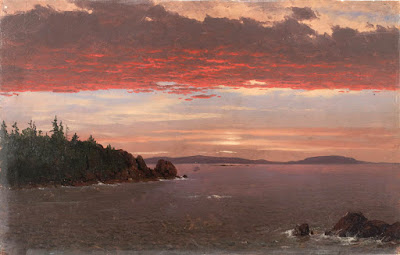A listener to the BBC podcast The Naked Scientists asks: ""Can you tell from a painting, or a photo, whether it's sunrise or sunset?"
My answer: No, there's nothing fundamentally different about the light effects at sunset or sunrise, and there's no way to tell which you're looking at from the light and color effects alone.
The cause of those light effects are the same. Sunlight travels through more atmosphere as the rays approach the horizontal. Passing through more air scatters out more blue wavelengths from the light rays, making the light that remains appear increasingly orange or red. As the sun passes below the horizon, beneath the curvature of the earth, it may briefly illuminate the bottoms of the clouds. Of course this effect happens both at sunrise and at sunset when colors are at their richest.
A single photo or a painting can tell you something about the position of the sun and about the height and distribution of cloud layers. And some art historians have argued that paintings of sunsets after the eruption of Krakatoa in 1883 reveal colors that were more pronounced worldwide. But it can't tell you whether it's morning or evening.
If there are differences between sunrise and sunset, they're qualitative and subjective. In some environments, humidity and dust may be stirred up at the end of the day because of evaporation and turbulence, and these effects can increase the saturation of the colors. But you wouldn't be able to guess that from a single image. Emotional subjectivity also plays a part in our human perception of sunsets and sunrises as we experience them in time. While a sunset builds gradually to a dramatic crescendo before quickly transitioning to twilight, a sunrise starts off with a blast of color and, as Wordsworth says, the "vision splendid" fades "into the light of common day."
---
M. Minnaert, author of the book "The Nature of Light and Color in the Open Air," addressed this topic and here's how he puts it: "Are there any differences between dawn and dusk? If any they are so small that it is not possible to mention any really typical differences. One important thing, however, is that the eye is completely rested in the morning and sees the light-intensity increase continuously, so that it is more sensitive to dawn phenomena than to dusk phenomena. The latter have generally a greater richness of colour on account of the greater humidity of the air, and because the air is a little more turbulent, and contains more particles of dust than in the morning." (page 280, paragraph 193)
Listen to the Q and A on The Naked Scientists Podcast: Can you tell if it's sunrise or sunset?








6 comments:
There was a program on public television that showed some of those deeply colorful red orange paintings after the volcanic eruption you mention.
I believe it showed they were at a museum in the UK.
Did anyone see that to add specifics, if you recall? Thank you in advance if so!!!
CerverGirl:
Perhaps a start:
https://publicdomainreview.org/2012/05/28/the-krakatoa-sunsets/
https://en.wikipedia.org/wiki/1883_eruption_of_Krakatoa
Here in the Salt Lake Valley I've noticed the sunrises are often very pink compared to sunsets which tend to be yellow or orange. This could a function of altitude however. To the East we have very tall mountain peaks and they are quite close (compared to where the bulk of the population is) so we don't see the sun until it's pretty high. To the west the mountain peaks are much shorter and farther away therefore the sun hits the mountains at a much lower altitude. At least that's all I can think of that would explain the difference, does that make sense?
I had the impression in general the air mass in the morning is cooler, which may account for some subtle differences in coloring. But I may be wrong.
Hey James, great post!
I recently had a commission to paint a diptych of a Sunrise/Sunset subject, so I had to research and contemplate this dilemma.
While the conditions are essentially the same as far as the light-angles and effects are concerned, the major difference I came up with is the viewers relationship to the events.
Sunrise is viewed from the ‘Night-side’ of the event, standing in the cooler atmospheric envelope. While Sunset is viewed from the ‘Day-side’ of the event, standing in the warmer atmospheric envelope.
Optically the temperature difference would be very slight, if noticed at all.
But as far as the color-pallet was concerned, I found that by using more saturated colors from the warm red-orange-yellow pigments: Cadmiums and Naphthal, surrounded by dark-blues and purples, made for a more ‘Setting-Sun’ effect…
While using colors from the relatively cooler red-orange-yellow pigments: Quinacridones, Alizarins and Arylide-yellows, surrounded by less saturated lavender-tints and warmer cerulean blues made for a more ‘Rising-Sun’ effect.
(My caveat for this post is that I have way more experience w Sunsets, and practically none w Sunrises.) -RQ
Here in southern NJ I find there's a marked difference driven I suspect by the Sun rising in the morning over the cool Atlantic Ocean, where the evening sunset is over warm land. We're close enough to the coast that the morning sky is illuminated by light reflected of the water, and on clear morning there not much dust in the cool dry air. And the morning sky often is cloudless where the afternoon sky can have considerable cloud cover due to daytime heating which also draws dust to the higher cloud layers.
Post a Comment